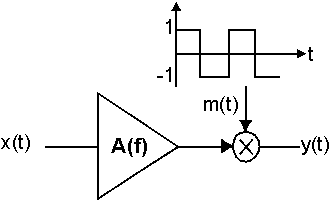Chopping: a technique for noise and offset reduction
5.3. Chopping seen as a modulation technique
Another method for noise and offset reduction is the chopping technique. Chopping is a modulation technique which shifts the spectra of low frequency stationary processes at multiples of chopper frequency out of the band of interest. To understand this, consider a stationary random process x(t) of autocorrelation function Rxx(t) and power spectral density Sxx(f) which is applied to a band limited amplifier A(f) as illustrated in fig.5.4. The modulation signal (chopper signal) m(t) is periodic with a period T and can be expanded in Fourier series:
 (5.8)
(5.8)
The Fourier transform of this signal is a sequence of Dirac pulses decaying with the order of the harmonic and having contributions only at odd multiples of the chopping frequency 1/T.
 (5.9)
(5.9)
The power spectral density of the output process y(t)=[Ax(t)]m(t) can be found from the following convolution:
|
|
|
Fig.5.4: Chopper modulation |
![]() (5.10)
(5.10)
This gives contributions only at the odd multiples of the chopping frequency 1/T:
 (5.11)
(5.11)
Therefore, the output power spectral density is a repeated replica of the input power spectral density at the odd multiples of the chopper frequency rapidly decreasing with the order of the harmonic. That is why foldover effects are not present in the case of chopping. This is the main difference between chopping and sampling methods.
